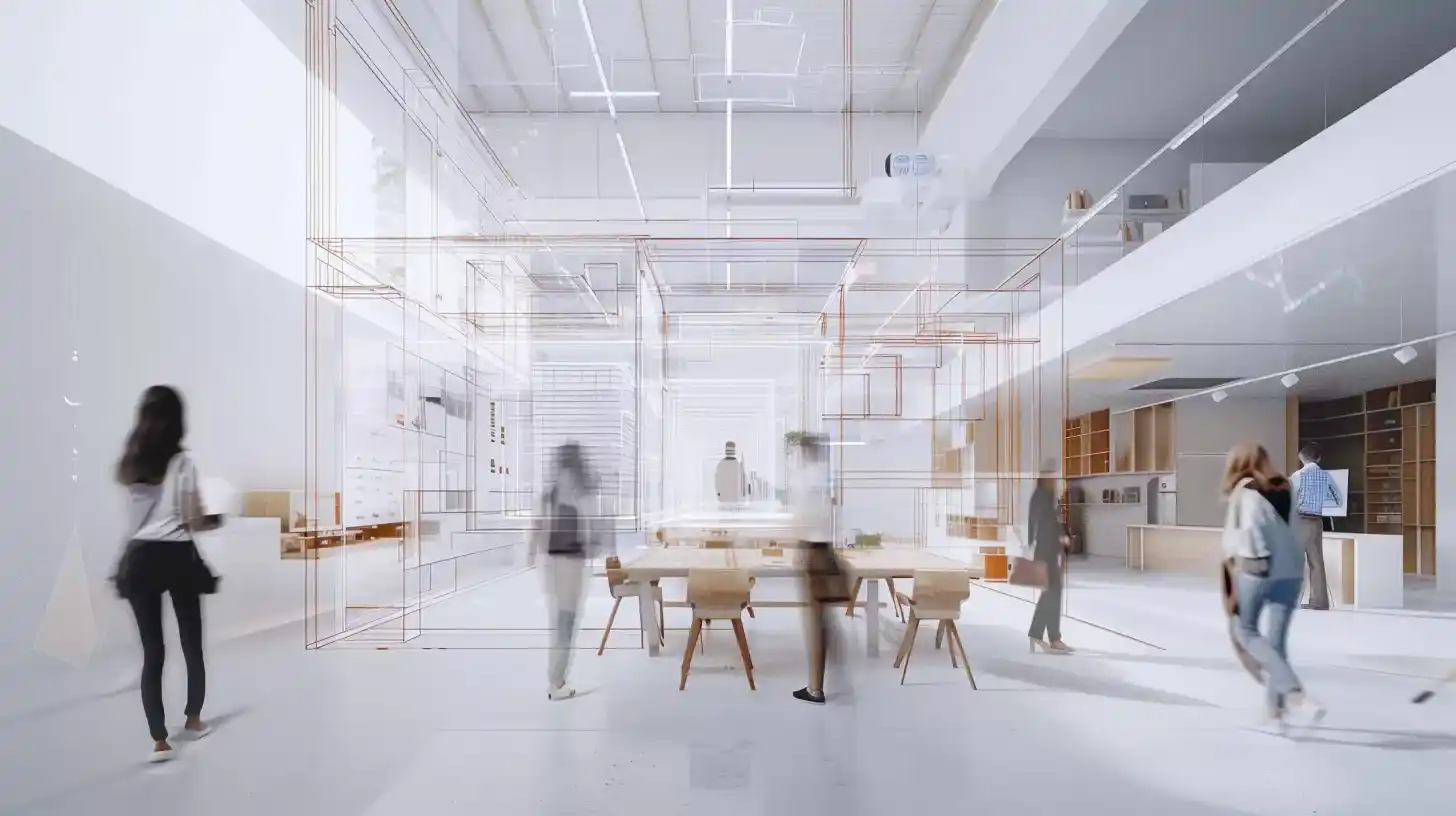Table of Contents
Artificial Intelligence (AI) in architecture is evolving as a potent tool, yet finds itself at an intriguing juncture of development. It excels in solving practical problems such as floor plan arrangements with remarkable speed and variation. Furthermore, AI can conjure expansive, creative visions sourced from the vast expanse of the internet, responding adeptly to concise text prompts. However, bridging these two realms of architectural design, the scientific and artistic aspects, remains a challenge.
The Role of AI in Architectural Design
In the realm of architectural design, AI in architecture operates through computer programs that mimic human cognition, solving intricate problems and dynamically responding to stimuli. A closely associated subfield, machine learning, enables AI in architecture systems to recognize patterns and autonomously improve their cognitive abilities.
AI is integrated into various stages of architectural design, aiding in concept generation and visualization. Image generators like Midjourney analyze internet imagery to produce detailed pictures from short text prompts, facilitating early concept brainstorming. These images serve as effective tools for public outreach and can be utilized in marketing materials to illustrate design concepts.
How AI is Used in Architecture Today
AI Revolutionizing Architectural Design Processes
The integration of AI in architecture design processes is founded on the development of computer programs designed to emulate human cognitive functions, facilitating problem-solving and adaptive responses to stimuli. An allied subfield, machine learning, further enhances AI systems by enabling them to discern patterns and autonomously refine their cognitive capabilities without human intervention.
Throughout the architectural design journey, AI in architecture has emerged as a pertinent tool. For instance, image generators like Midjourney leverage AI algorithms to analyze internet imagery and generate detailed, high-quality visual representations based on concise text prompts. This technological capability proves invaluable during early concept ideation, akin to sketching ideas on a napkin. Moreover, these generated images serve as effective communication tools, aiding in conveying design concepts to a broader audience and enhancing marketing and promotional materials with visually compelling content.
Benefits of Using AI in Architecture Design
Efficiency and Optimization
AI technology in architectural design significantly streamlines the completion of routine, repetitive tasks, epitomizing what is commonly referred to as artificial narrow intelligence. Particularly effective in areas where these tasks intersect, AI swiftly generates apartment layouts within residential towers, tailored precisely to developers’ requirements. Furthermore, it adeptly fine-tunes these designs to optimize material usage and cost-effectiveness, marking a notable advancement in design efficiency.
Creative Inspiration
Additionally, image generators can work as an unparalleled “mood board” for design inspiration, offering a quick visual synthesis drawn from vast image libraries. These detailed images can give architects an aesthetic target to aim for as they define structural and engineering systems.
Leveraging AI for Enhanced Design Processes
Enhancing Efficiency with AI
AI tools streamline architectural design by automating repetitive tasks and optimizing designs incrementally. These tools, often categorized as artificial narrow intelligence, efficiently fill residential towers with apartments tailored to developer specifications, considering factors like material efficiency and cost optimization. Moreover, image generators serve as invaluable mood boards, offering visual synthesis and inspiring architects during the design process.
Advancements in Generative AI in Architecture
With advancements in AI computing power, generative AI is gaining traction among architects and designers. Unlike conventional methods that generate variations based solely on constraints, generative AI in architecture evaluates the quality of each variation against user-defined metrics, enhancing the design exploration process.

Illustrative Examples of AI Applications in Architecture
1. Streamlining Schematic Planning with AI
Tools like Finch facilitate parametric planning, enabling architects to generate floor plans and dynamically adjust them based on input constraints. These tools consider local planning regulations and optimize designs for structural efficiency, providing architects with versatile design solutions.
2. Empowering Urban Development with AI
Cloud-based platforms like Autodesk Forma leverage AI-powered insights to simplify the exploration of design concepts and evaluate environmental qualities surrounding building sites. By performing real-time analyses, Forma assists architects in meeting business and sustainability targets from the early stages of the design process.
3. Optimizing Bidding Processes with AI
Companies like ConXtech utilize AI to streamline the bidding process in construction. By leveraging AI algorithms to determine the most cost-efficient structural steel design, companies can reduce bidding cycles and optimize project costs effectively.
Will AI Replace Architects?
Assessing the potential impact of AI on architecture jobs is a complex task, particularly considering the nascent stage of AI integration within the field. While AI demonstrates proficiency in tasks such as assembling technical details and plans, it’s challenging to predict the extent to which it will reshape architecture jobs. It seems inevitable that AI’s capabilities may reduce the demand for entry-level designers who traditionally handle these tasks.
However, it’s essential to acknowledge that AI’s role in alleviating architects from mundane detail-oriented work is undeniable. Yet, there’s a pertinent concern regarding employers’ inclination to exploit AI’s labor-saving capabilities to accelerate production pace. This raises questions about the future balance between AI-driven efficiency and the preservation of human creativity and expertise in architectural design.

Navigating the Future of AI in Architecture
Despite AI’s transformative potential in architectural design, significant challenges remain. AI’s inability to define project constraints and its limited understanding of human interactions within architectural spaces pose obstacles to widespread adoption. Additionally, AI algorithms are constrained by the quality and diversity of available data, impacting their effectiveness and reliability.
As AI continues to evolve, it holds the promise of augmenting human creativity and streamlining design processes. By striking a balance between human ingenuity and machine intelligence, architects can harness AI to unlock new possibilities and shape the future of architectural design.
Related Article: Future of AI Architecture: 5 Dynamic Trends and Predictions
Conclusion: Embracing AI in Architecture
The fusion of AI and architecture marks a significant step forward in design evolution. AI streamlines tasks, inspires creativity, and optimizes designs, revolutionizing architectural processes. While AI enhances efficiency, architects remain crucial for creativity and human understanding. Looking ahead, AI promises even greater potential for innovation. By embracing AI, architects can redefine design, solve challenges, and shape a more responsive built environment. Let’s embark on this journey together, where AI and architecture converge for a future of endless possibilities.
FAQs
How is AI being used in architecture?
AI can help architects uncover patterns or correlations between many aspects in materials research that humans may ignore. This could open up new avenues for innovation, potentially leading to the creation of breakthrough building materials in the future.
What AI can create architectural plans?
Hypar is regarded as the greatest AI tool for design automation and collaboration. Hyper, as a cloud platform, enables architects to efficiently collaborate with other construction industry specialists, accelerating both the design and construction processes.
How many architects are using AI?
Engineering and landscape architecture were also involved, though to a lesser level. Currently, over 46% of respondents use AI tools for their projects, with an additional 24% planning to use them in the future.